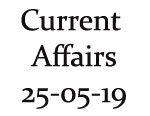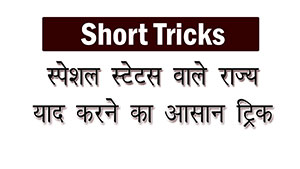-
Current Affairs 25th May 2019
Updated : 25-May-2019
Current Affairs 25th May 2019 - Important Points
- India to clash with New Zealand in first warm-up match on - 30th May 2019
- Restricted Ozone-Depleting CFC continued to be by - China
- Algeria and Argentina announced Malaria-Free by - WHO
- Railways Track Electrification Project in India financed by - ADB
Current Affairs 25th May 2019 - Details
India to clash with New Zealand in first warm-up match on - 30th May 2019
The much-awaited ICC Cricket World Cup-2019 is planned to start on May 30th, 2019. Virat Kohli headed Indian team, will be facing New Zealand team in its 1st warm-up match on May 25th, 2019 at the Oval, London.
In total, Indian team will play 2 warm-up matches before formally entering the world cup. The 2 nd warm-up match would be against Bangladesh team on May 28th.
Key Highlights
Indian Side
The important players for India will be Virat Kohli, Rohit Sharma & Jasprit Bumrah.
Shikhar Dhawan & Rohit Sharma are likely to begin the match trailed by Virat Kohli at number three & Vijay Shankar, M.S.Dhoni & Kedar Jadhav as the middle-order batsmen.
Besides them, Team India has 2 all-rounder players Hardik Pandya & Ravindra Jadeja & Jasprit Bumrah & Mohamed Shami as frontline bowlers.
All eyes will also be on Kuldeep Yadav & Yuzvendra Chahal also.
New Zealand Side
The crucial players for New Zealand team will be captain Kane Williamson, Ross Taylor & Trent Boult.
Kane Williamson is believed to lend the batting power to the Kiwi’s side along with Martin Guptill & Ross Taylor.
On the other hand, Trent Boult & Tim Southee will have the major responsibility of the ball.
Since it is a warm-up match, both the sides will be able to utilise their full 15 members squad.Restricted Ozone-Depleting CFC continued to be by - China
As per to a fresh research released in journal Nature, China continues to utilise the restricted ozone depleting chemical known as CFC-11 in violation of Montreal Protocol.
Important Findings of Report- Despite being a guarantor to Montreal Protocol, and likeminded to phase-out the manufacture of harmful CFC-11 in 2010, China continues to emit ozone depleting CFC-11 in violation of Montreal Protocol.
- An early study about a year ago found new global emissions of CFC-11 gas, which many researchers, environmental groups and policymakers had alleged but were only able to trace source generally as East Asia.
- Fresh findings by international team of scholars assured about suspected region and claimed that emissions of ozone layer damaging gas are coming from eastern China, mainly from its 2 heavily industrialised states namely Shandong province and Hebei province.
- These 2 provinces create between 40 percent and 60 percent of total global CFC-11 emissions from Eastern China.
- In years between 2008 and 2012, Eastern China released an average of about 6400MT of CFC-11/year, the emissions augmented by 25 percent in 2012 and since 2013 CFC-11 emissions were increasing.
- This number then amplified to an average of about 13400MT of CFC-11/year in years between 2014 and 2017.
- China has world’s largest polyurethane foam market which is responsible for about 40 percent of world’s total consumption.
- The research also found signal that factories in Shandong province were still making and consuming gas to produce foam insulation.
Algeria and Argentina announced Malaria-Free by - WHO
The WHO has announced Algeria and Argentina as “Malaria-Free” nations after no cases of local
transmission of disease were found.
Important Highlights- The Malaria parasite was 1st found in humans in Algeria by a French physician termed Charles Louis
Alphonse Laveran in 1880. By 1960s, Malaria became Nigeria’s primary health challenge, with reporting almost 80000 cases/year. - The nation then began its steps towards responding to disease.
- On the other hand, Argentina started is elimination efforts in 1970s.
- The native transmission of disease was last recorded from Algeria in 2013, while last case of Argentina was reported in 2010.
- Algeria became 2nd nation in Africa to be announced malaria-free, after Mauritius, which was certified in 1973.
- Argentina became 2nd nation in South America to be certified malaria free after Paraguay, which was certified in June 2018.
- The certificates will be presented to both nations on side-lines of the 72nd session of the World Health Assembly which is being organise in Geneva, Switzerland.
Steps Taken by both nations
Better-quality surveillance which assisted every last case of malaria to be quickly identified and treated.
Free diagnosis and treatment of patients made sure that no one was left behind. This assisted to prevent, detect and cure the disease.
Railways Track Electrification Project in India financed by - ADB
The Asian Development Bank has inked a contract to electrify railway tracks in India under Railways Track Electrification Project. According to the contract Asian Development Bank will issue $750 million long-term financing to Indian Railway Finance Corporation.
More about Loan Contract- It is the largest single non-sovereign loan ever promised by Asian Development Bank to a member nation.
- It was relesed as part of Railways broad modernization programme which will benefit India’s railway sector to shift from dependence on fossil fuels to electric power.
- The electrification assets will be hired to Indian Railways under a long-term lease contract.
- Indian Railway Finance Corporation will utilise loaned amount to install electric traction equipment along 3378 kilometres of existing railway lines, so as to enable migration of passenger and freight traffic from diesel to electric traction.
- This is a flagship project to validate Asian Development Bank’s strategy of supportive the key state owned enterprises in strategic sectors and also demonstrate a major push by Asian Development Bank’s private sector operations into transport infrastructure, and particularly railways.














